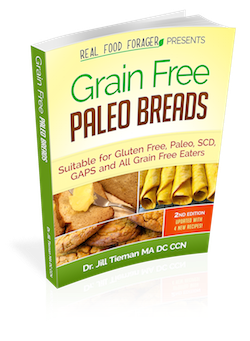The Specific Carbohydrate Diet and the GAPS diet require grain-free baking. Almond flour is a great alternative. However, it is difficult to find almond flour from blanched organic almonds and impossible to find almond flour from blanched organic almonds that have been soaked and dehydrated. The conclusion I came to was that I would have to make my own and it really is not that hard once you decide which almonds to use.
The issue with almonds is that the USDA in it’s wisdom now requires all raw almonds to be pasteurized. There are two methods of pasteurization: chemical or steam. Most commercial raw almonds are now heated and chemically pasteurized (and they are still allowed to be labeled “raw”). This defeats the purpose of eating “raw” almonds as they no longer have the beneficial enzymes after being subject to heat and chemicals.
The other method of pasteurization is by steam heating which in my opinion is more acceptable as it is at a low heat and is said to affect only the outer layers of the nut.
(There actually is a third option which is to buy “really raw” almonds from a reputable grower. These are more expensive and if you are going to wind up blanching (which requires heating them) and/or cooking with them I do not see the purpose in spending the extra money for these almonds.)
Consequently I decided that the organic steam pasteurized almonds were the ones I would use. After I made that decision, it was easy to obtain them at a fair price.
In order to make almond flour, blanching is necessary. Typically, this is accomplished simply by boiling a pot of water, throwing the nuts into the water for about 10 seconds and them straining them. The rest of the time is spent popping the almonds out of their skins.
If you are using organic almonds that have been steam pasteurized you simply have to soak the nuts in warm salt water as you would any other nut. After about one hour, you can pop them out of the skins (which contain most of the phytates) and continue to let them soak for the 8 hours.
Soaking Nuts in a Brine is Important
Why soak the nuts for 8 – 10 hours in salt water? This is really essential in order to remove phytic acid and enzyme inhibitors that are present in the nut. While these substances protect the nut from premature sprouting, it is not wise to eat nuts that have not been properly prepared in the traditional method of soaking and/or sprouting. This preparation method neutralizes the enzyme inhibitors and makes the nut a perfect snack that is much easier to digest. This is especially important for people on SCD or GAPS who already have digestive issues.
In her wonderful book Nourishing Traditions, Sally Fallon Morell teaches us how to soak and/or sprout various nuts. Many traditional cultures used salty sea water to soak nuts and the sun to dry them. In our culture we can use a good quality sea salt and water to soak the nuts, and the oven (at between 135 and 150 degrees ) or a dehydrator to dry them.
Homemade Almond Flour
Ingredients
1 1/2 pounds organic raw almonds (steam pasteurized)
sea salt
Instructions
- Add 2 heaping teaspoons of salt to a 3 quart pot of water
- Stir until the salt is dissolved
- Add the almonds and stir
- Let soak for 8 – 10 hours at room temperature or a little warmer
- After soaking, drain the water
- Put the almonds in a bowl and pop them out of the skins
- Discard the skins
- Dehydrate the skinned nuts on a cookie sheet in the oven between 135 and 150 degrees for 12 – 14 hours
- This should yield about 4 – 6 cups of almonds
- Place the almonds in the food process and process until it is a flour consistency
- Be careful not to over process or you will get a nut butter (this is also fine for eating and baking)
- Store almond flour in the freezer
This post is linked to: Sugar-Free Sunday, Savory Sunday, Melt in Mouth Monday, Monday Mania, Meatless Monday, Midnight Maniac, My Meatless Monday, Mangia Monday, Mouthwatering Monday, Weekend Carnival, Tuesday at the Table, Delectable Tuesday, Tuesday tasty Tidbits, Made From Scratch Tuesday, Traditional Tuesday, Tasty Tuesday, Tempt my Tummy Tuesday, Slightly Indulgent Tuesday, Tasty Tuesday, What’s on the Menu, What’s Cooking Wednesday, What’s Cooking Wednesday, Real Food Wedmesday, Made it on Monday, Healthy2Day Wednesday, Cast Party Wednesday, These Chicks Cooked, Foodie Wednesday, Creative Juice Thursday, Gluten-Free Wednesday, Full Plate Thursday, Frugal Follies, Turning the Table Thursday, Simple Lives Thursday, Recipe Swap Thursday, Pennywise Platter, Food Trip Friday, Real Food Whole Health, Foodie Friday, Fresh Food Friday, Foodie Friday, Friday Favorites, Fight Back Friday, Fat Camp Friday, Fun With Food Friday, Friday Food












